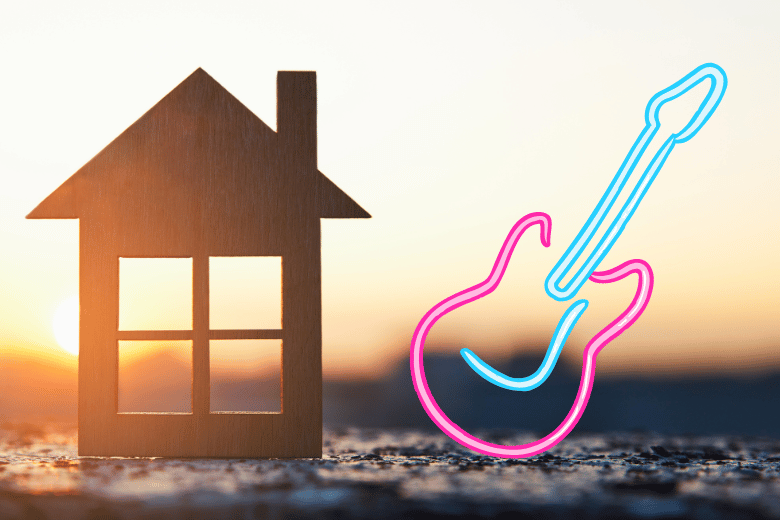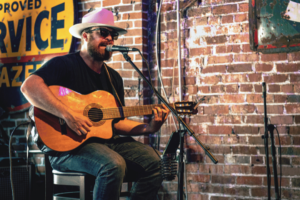From inadequate space to easily-annoyed neighbors, the at-home guitar player faces no shortage of challenges in the quest for that perfect sound.
However, with proper planning and research, getting a professional-grade guitar sound from your own friendly confines is quite simple.
For help in this regard, please keep reading for some of the best acoustical solutions that will make your guitar sound its best at home.
“technical factors in home studio design that are important for helping you sound your best, never underestimate the importance of creating an environment that gets you playing at your best”
1- Invest in High Quality Acoustic Panels

Many musicians stress about their neighbors when it comes to playing at home. While you definitely don’t want an angry mob banging on your door to keep it down, that is not the only consideration regarding soundproofing a studio.
In many cases, the studios that transmit a bunch of sound waves through the walls also see a high rate of echo and reverberation. This creates annoying feedback that makes it impossible to lay down the perfect track.
Therefore, it is crucial to equip your music room with high quality acoustic panels. The best panels will provide a noise reduction coefficient (NRC) of .95 per inch, just short of the energy standard (1) for complete noise absorption. Thicker two-inch panels can actually exceed an NRC of 1. As modern acoustic panels mount to walls similar to a picture frame, they provide a simple, understated means of promoting quality sound.
2- Upgrade to Hardwood Floors

Straight up: installing hardwood floors will require a financial commitment. In some cases, the total price after installation will exceed $12 per square foot.
However, hardwood floors absorb sound far better than cheaper vinyl tile or laminates. They will also reduce wear and tear better than carpets.
If you are financially unable to upgrade to hardwood, consider adding some area rugs to keep sound from vibrating off your floors. Some high-usage home studios even apply rubber mats to the entire studio floor to add sound absorbing mass.
Imagine playing acoustic guitar in this room!
3- Don’t Neglect the Ceiling

Adding acoustic ceiling clouds is a must if you have to set up shop in the living room or other areas of the home that feature high vaulted ceilings.
They can help absorb sound and reduce echo during recording sessions. Even if your studio has an average roof height, ceiling insulation can’t hurt. The good news is that adequate ceiling insulation occupies less than 50% of the ceiling surface.
4- Have a Plan for the Windows

Windows are a bit of a controversial topic regarding home recording studios. While some genres and artists benefit from a dose of natural sunlight, others prefer darker recording confines or environments that allow more control of the lighting process.
The sharp angles of window frames cause some sound distortion as well.
Therefore, it is vital to treat windows with the appropriate shading materials. Wood blinds are a solid choice thanks to wood’s sound absorbing properties. More comprehensive fabric shades are also a healthy option for windows that need more complete coverage.
5- Guarantee Uninterrupted Power

Nothing can kill the quality of a track quite like an unexpected power outage.
In most cases, it is better to start over from scratch than to try and pick up where you cut out. Splicing together segments can be challenging. It just really sucks when the power outage comes during your best session to date.
Therefore, guarantee that your best track does not go by the wayside with an uninterrupted power supply (UPS). A UPS functions like a giant battery pack that kicks in when your primary power source fails. While you won’t be able to record forever on a UPS, you should be able to go for at least an hour.
This gives you plenty of time to wrap up the session and find a logical place to stop that guarantees your best track is preserved.
6- Never Underestimate the Importance of Ambience

Photo by Ângelo Mariano M.
Finally, while there are many technical factors in guitar room setup that are important for helping you sound your best, never underestimate the importance of creating an environment that gets you playing at your best.
This will look different for every player. As mentioned, some folkier acoustic guitar players may play better with natural sunlight beaming. In comparison, grungier players may want something a bit darker.
One important concept is to adorn your studio with sources of inspiration. For many guitar players, their playing is an intensely personal form of expression, so don’t be afraid of decorating the space with relics from your musical journey.
Framed lyrics of a song you wrote, the very first guitar you learned to play on, or even a picture of you jamming out with friends are some ideas from which you can draw inspiration.
Go the Extra Mile to Get the Best Sound at Home
With the proper research and planning, it is feasible for guitar players to get their best sound at home. From investing in quality acoustic panels to creating the perfect playing environment, choose from any of the 6 ideas listed above to get the best sound in your home studio!
FAQs
Author

Stephanie Rogers is a freelance writer that enjoys sharing her love for writing with others. She primarily writes about home remodeling, interior design ideas, and landscaping, but lately has started writing more about her passion for Music. She lives in her hometown of Phoenix, Arizona where she enjoys spending time with her husband and dog, Chino.








